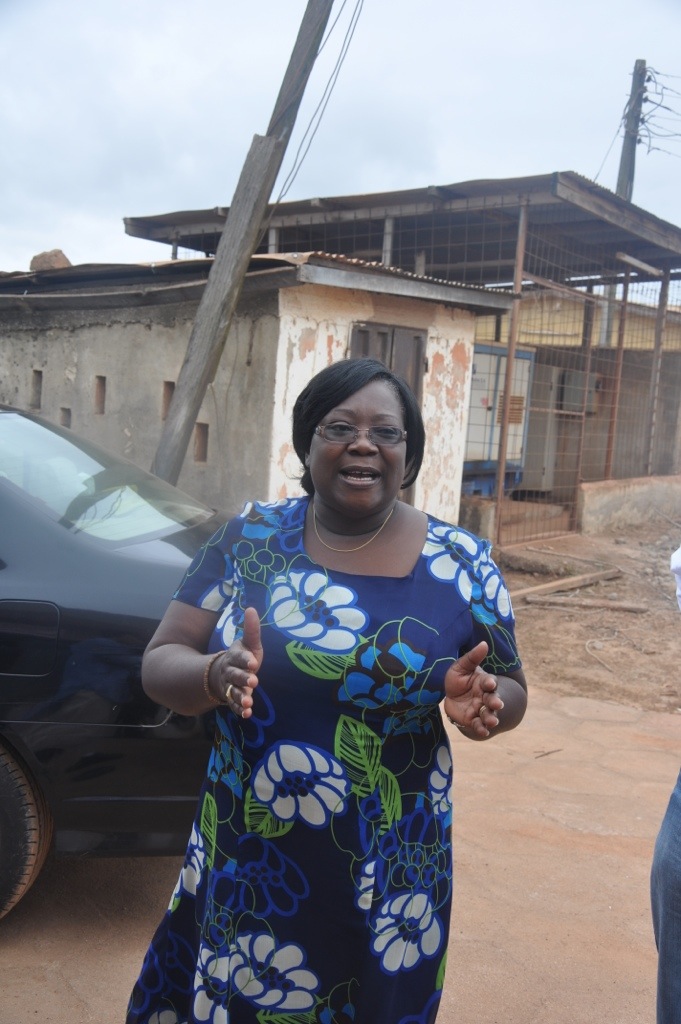Final breakfast at The Four Villages Inn and goodbyes to our hosts, Charity and Chris. We enjoy this vey cozy place. It’s like coming back home annually.
We set out into the normal heavy traffic and our birthday boy, Dick (I won’t tell you his age, but it rhymes with heaven-tea son), is not at all happy that we’ve added a stop to the itinerary. Fortunately, the rest of us are willing to cut the crabby old guy a little slack today.
To simulate the long, trafficy ride, I’ll tell you a little about the Ghana roadside. Displayed outside are goods of every type imaginable, ranging from small food stands to furniture of all types to windows to caskets.
The influence of religion is everywhere. Trucks and autos have sayings stenciled on them such as God is Able, God’s Gift or Dependable God. The shops bear similar notions. Among those I noticed were: God is My Helper Decorator, Jehovah Plumbing, God is Able Carpentry Shop, God’s Way Computers, Choose Jesus Beauty Salon, Hand of God Stationery Depot, Be Holy Electric, Fair Heaven Herbal Shop, No King as Allah Enterprise, Thank You Jesus Phones & Accessories, God First Cosmetics, and, my personal favorite, Good Father Unisex Fashion Design (I think I’m going to start franchising those when I get back home). Schools also show the religious influence, Oasis of Love School. Go you fighting Oasis of Love tigers!
We reach our destination, the Supereso District Maternity Hospital, which Dr. Annie and Funmi have pushed us to see (over Dick’s protest. We are met and shown around by
Abeena Boateng, who runs The Millennium Cities medical operations in subsaharan Africa. Funmi knows Abeena and has contacted her by email to arrange this. When I ask Funmi how she knows Abeena, she says, “I know everyone.”. This is not boasting; it’s true.
In this clean facility–we have to wash our hands and wear slippers and hairnets to enter, mothers kept 48 hours instead of 6-12 in Dr. Annie’s small maternity ward. By keeping watch on them, they are able dramatically to reduce infant mortality, which is high in the first 30 days and often not reported. Babies are not named for week, because they may not survive. The facility emphasizes a “kangaroo program”, which has mothers holding babies close to themselves, sharing body heat, avoiding hypothermia, and also helping bonding between mother and child. They teach mothers how to breast feed. The facility is another good example of Global Health, as it was built by Israel, who also provided training for the nurses.
As we enter the car for the long ride to our next stop, even Dick has to admit that this turned out to be more interesting than he’d anticipated. And Abeena will be a valuable contact for the future. She also provides training for kindergarten teachers.
In the SUV, Sola reads us an article from his iPhone about a very large public health worker initiative in the US, so perhaps we’re catching up with Ghana and the rest of the world. En route we also have a chance to read through the amazingly candid report we were given yesterday by the district with comprehensive statistics on income, water, health, etc and analyses of what has gone wrong and why. The report was prepared by a national commission and, in it’s candor, is unlike any you’d find in the US.
Our ride is some three or four hours, some of it, because of a short cut, over extremely bumpy. bone-jarring roads. We are all happy to arrive at Mansokwaa. Here we are treated to the type of full-blown ceremony that we’ve witnessed in past years, with extensive speechifying and a ribbon cutting ceremony for the new block of school rooms donated by friends of the Kipharts. The community expresses its gratitude, and at the same time asks for additional funds (again, typical of what we’ve seen in past years).
The school facilities are decked out in a fresh coat of paint, and Sola cannot believe what has been accomplished here, in the middle of nowhere. Though school is out, all of the children are in attendance, along with many others in the community. The community has rented a sound system for the occasion (for which it collects donations during the ceremony), which blares very loud Ghanaian music, which women and children dance to. After the ribbon-cutting ceremony, we all walk a short distance through a cocoa grove to see a small, even more remote village.
We pile pack into the SUV and head for Cape Coast, where we will spend the next two nights. Cape Coast used to serve as a jumping off point for the slave trade in the 19th century. On our first trip to Ghana, we visited the castle in which the slaves were held in horrific conditions before they were shipped out.
We are met at the hotel by Joe and Ida (reminder: if you’re having trouble identifying the characters, you can go back to my first post under Ghana, 2012, where they are identified). After a brief stop at the room, we go to the outside deck, where Joe and Ida have arranged a great birthday surprise for Dick, a performance by the dancers from the School for the Deaf, which Dick and Susie have supported. Joe and Ida have persuaded the leader, the drummers and the dancers to come back before school has started to perform. Carol and I have enjoyed the inspirational performances by these young people in each of the last two years.
After the performance we have the birthday cake the Kwartengs have ordered, then retire (or, in my case, blog).










Leave a Reply